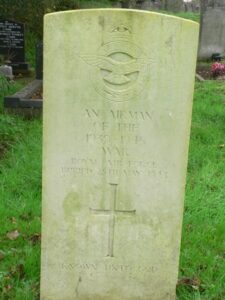Pembrey is a village situated between Burry Port and Kidwelly, overlooking Carmarthen Bay. The men of Pembrey who lost their lives in both World Wars are commemorated by a memorial organ inside St. Illtyd’s Church, and also on a War Memorial outside Pembrey Community Centre, which contains the details of the men of Burry Port who fell. Due to the large number of names, I have split the memorial into two separate pages, for Burry Port and Pembrey. This page commemorates those of Pembrey who fell. Several men from the area are not listed on the memorial, and so are shown below. Many thanks are due to Pauline James, of the Carmarthen Family History Society for her photographs of the memorial.
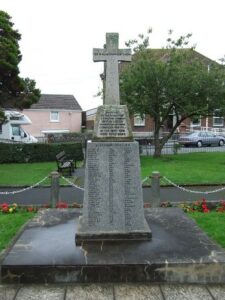
The Great War, 1914-1918
Andrew Barbour, Private, 49368, Lancashire Fusiliers. Andrew was the son of William and Jane Barbour, of Springwell Place, Stewarton, Ayreshire. He worked in Pembrey prior to the war and enlisted there into the Royal Engineers. He subsequently transferred into the 19th Battalion, Lancashire Fusiliers, who were attached to the 49th (West Riding) Division as Pioneers. The Division moved to France during April 1915 and saw its first major action on the Somme, during the Battle of Albert. They remained on the Somme, taking part in the Battle of Bazentin, the Battle of Pozieres, and the Battle of Flers-Courcelette, and the following year saw action at Third Ypres, during the Battle of Poelcapelle. The Division remained in Flanders over the final winter of the war, and it was here that they met the brunt of the German attacks on the Lys in April, 1918, taking part in the Battle of Messines, the Battle of Bailleul (and the Defence of Neuve Eglise), the First Battle of Kemmel, and the Second Battle of Kemmel. After the tide of war had been turned, with the Allied successes on the Somme during August, 1918, they took the offensive. The 49th Division took part in the resulting Pursuit to the Selle, the Battle of the Selle and the Battle of Valenciennes, which saw the war out. Andrew was killed in action during the Pursuit to the Selle on 13 October 1918. He was 32 years old, and is buried at Haspres Coppice Cemetery, Haspres, France. Andrew is not commemorated locally.
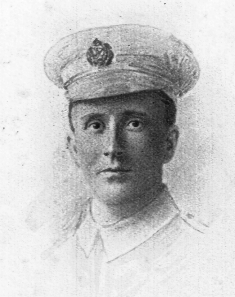
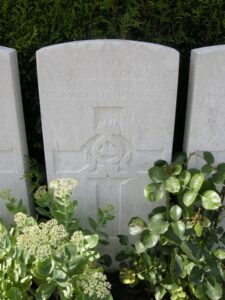
George Bargewell, Ships Steward, 130104, Royal Navy. George was born at Pembrey on 30 September 1869, the son of George and Mary Bargewell. His father worked for H.M. Coastguard, and by 1881 the family had moved to Saundersfoot. George joined the Royal Navy at some time prior to 1891, and was the husband of Mary Louisa Bargewell, of 61, Station Rd, Keyham, Devon. During the war George served aboard the S.S. Romeo, a civilian ship which had been chartered by the Admiralty to carry supplies for the Royal Navy. On 3 March 1918 Romeo left Scapa Flow bound for Liverpool when she was torpedoed and sunk by a German submarine. George was 48 years old when he died that day, and is commemorated on the Plymouth Naval Memorial, Devon. George is not commemorated locally.
Daniel Charles Bevan, Seaman, R/6216, Royal Naval Division. Daniel was born on 26 June 1897, the son of John Arthur Bevan and Margaret Bevan, of Wenfa House, Pembrey. He was an Army Reservist prior to the war, and then joined Anson Battalion, Royal Naval Division. The Naval Brigades were originally sent to Antwerp and Dunkirk in September and October 1914 to guard against invasion by the Germans. However Antwerp fell to the Germans soon after, and so many of the RND units were withdrawn to England. After a lengthy period of refit and training the Division moved to Egypt preparatory to the Gallipoli campaign. Landing on 25 April 1915 the Division transferred from the authority of the Admiralty to the War Office on 29 April 1916, and was redesignated the 63rd (Royal Naval) Division on 19 July 1916. The Division moved to France, arriving at Marseilles during May 1916 and moved to positions on the Somme, where it took part in the Battle of the Ancre, and the resulting Operations on the Ancre. In April 1917 the Division was at Arras, and fought at the Second Battle of the Scarpe, where they captured Gavrelle. They then fought at the Battle of Arleux, before moving north to Ypres, where they took part in the Second Battle of Passchendaele. Their next major action was at Cambrai, during the Action of Welch Ridge, and they were still in the area when the Germans launched their Spring Offensive, and fought at the Battle of St Quentin, where Daniel was killed in action on 24 March 1918, aged just 20. He has no known grave, and so is remembered on the Arras Memorial, France.
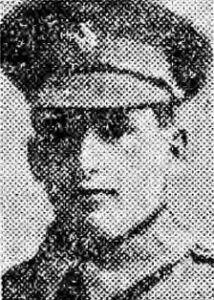
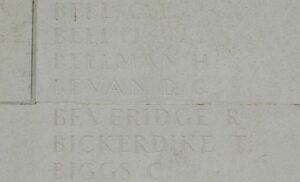
George Bradley, MID, Private, 306557, Royal Warwickshire Regiment. George was the son of George and Mrs. Bradley, of Lincoln. He resided with Annie Llewellyn Jones at Derwydd Bungalow, Burry Port prior to the war and enlisted at Pembrey on 10 December 1915 into the Royal Warwickshire Regiment. On 25 July 1916 he landed in France and was posted to the 1/8th Battalion, Royal Warwickshire Regiment, which was attached to 143 Brigade, 48th (South Midland) Division on the Somme. George saw his first action during the Battle of Bazentin, during the second phase of the Battle of the Somme, where the division captured Ovillers. They also fought at the Battle of Pozieres and the Battle of the Ancre. In March 1917 the division followed the German Retreat to the Hindenburg Line. George was Mentioned in Despatches on 9 April 1917, for his bravery during this period. The division then fought at the Third Battle of Ypres, before being posted to Italy on 21 November 1917, where it remained for the duration of the war, taking part in actions on the Asiago Plateau. George was killed in action during the Battle of The Piave River, on 15 June 1918, aged 30. He is buried at Magnaboschi British Cemetery, Italy. George is not commemorated locally, as by then Annie had moved to Yorkshire.
Joseph Bulcock, Private, 63064, Welsh Regiment. Joseph was the son of Joseph and Elizabeth Bulcock, of 16, Fir Street, Burnley. He resided at 69, Pottery Street, Llanelli prior to the war, playing football for Swansea City AFC, and enlisted at Pembrey into the Pembroke Yeomanry on 11 December 1915. On 29 September 1917 Joseph landed in France, and was posted to the 9th Battalion, Welsh Regiment, which was at Ypres attached to 58 Brigade, 19th (Western) Division. The Division had been in France since July 1915, and moved to positions near Loos. The Division fought during the opening attack of the Battle of Loos, and then moved to the Somme, where they took part in the second wave of the attack on Ovillers-La Boiselle on 1 July 1916, capturing the village at heavy cost, and fought through the Somme Battles of Pozieres and the Ancre in 1916. They then moved north to Ypres, taking part in the Battle of Messines, and fought on the Menin Road. The division then moved south to the Hindenburg sector north east of Bapaume for the winter, and on 21 March 1918 were hit by the German offensive, Operation Michael, suffering heavy casualties over the coming days. The battered division then moved north, taking up positions again along Messines Ridge. Unfortunately the division was hit again, by a renewed German offensive on the Lys, which was launched on 9 April, and took part in heavy fighting over the coming days. Joseph was wounded by a bullet in the head during the Battle of the Lys. He was transported back to the Casualty Clearing Station at Haringhe for treatment, but died of wounds there on 20 April 1918, age 39. He is buried at Haringhe (Bandaghem) Military Cemetery, Belgium. Joseph is not commemorated on the Pembrey memorial, but on a recently installed memorial at Swansea FC. The photograph of Joseph has been kindly provided by Catherine Roseden, his great niece.
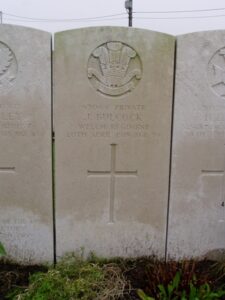
Frederick Arthur Campbell, Second Lieutenant, Tank Corps. Frederick was born at London in 1884, the son of Robert Andrew Campbell and Eliza Campbell. He married Frances Mary Harries, of Sunny Bank, Gws-cwm Road, Pembrey in 1917 while home on leave from France. He had been commissioned from the Seaforth Highlanders into the Tank Corps, and served with their 2nd Battalion. On 21 March 1918 the Germans launched their infamous assault, Operation Michael, on the Somme, and drove the British back from the Hindenburg Line. On 22 March Frederick’s battalion moved into action in an attempt to slow the German advance. His tank was one of four from the battalion that was destroyed during the gallant attack on the Germans that day. Tank crew were not popular among the German soldier, and prisoners were rarely taken. Frederick was 34 years old, and is remembered on the Pozieres Memorial, France. Frederick is not commemorated locally.
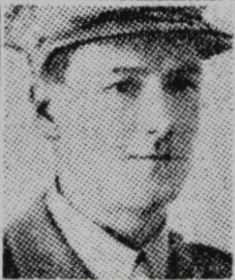
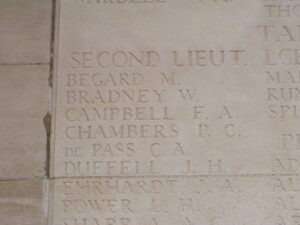
William Johnston Campbell, Private, 310004, Gordon Highlanders. William was born at Stewarton, Ayrshire, and enlisted at Pembrey into the army. He was sent to France, where he joined the 7th Battalion, Gordon Highlanders, attached to 153 Brigade, 51st (Highland) Division. The Division had been in France since May 1915, and saw the first gas attack at Ypres. They then fought at the Battle of Festubert, and took part in an attack near Givenchy on 15 June 1915. They then moved to the Somme, and took part in heavy fighting at High Wood in late July 1916. They captured the enemy strong hold of Beaumont-Hamel on 13 November 1916, taking more than 2,000 prisoners. During December and January in the bitter winter of 1916-17, the Division remained on the Somme in the area of Courcelette, and saw their next major action in the opening days of the Battle of Arras, capturing Rouex, before moving north to Ypres. Here they took part in the opening assault of the Third Battle of Ypres, on 31 July 1917, at the Battle of Pilckem. They advanced on Langemarck before being relieved. They then took part in the Battle of the Menin Road before being moved south, where they took part in the Battle of Cambrai, attacking in the area of Cantaing and Flesquieres. William was killed in action here on 20 November 1917, and is buried at Orival Wood Cemetery, Flesquières. William is not commemorated locally.
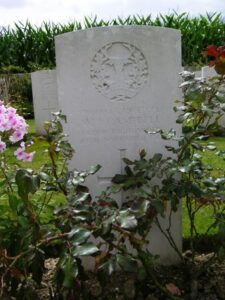
William Lewis Christie, Third Engineer, Mercantile Marine. William was the son of Alexander and Alison Turnbull Christie, of Denholm, Victoria Avenue, Quinton, Birmingham. He served in the Mercantile Marine aboard the SS Malda, which was a Clyde built Passenger Cargo Vessel. On 25 August 1917, she was torpedoed by the German Submarine U70, 130 miles West by South of Bishop Rock. She had almost finished her voyage from Boston for London. William’s decomposed body was found washed ashore at Towyn Point, Pembrey. He is buried at Pembrey (St. Illtyd) Churchyard. He was 28 years old. William is not commemorated locally.
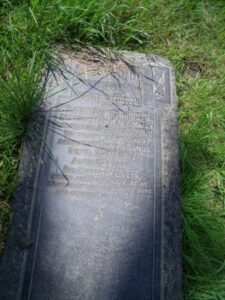
James Davies, Private, 17075, South Wales Borderers. James was the son of David and Mary Davies, of Penstar Farm, Pembrey. He enlisted at Llanelli into the 6th Battalion, South Wales Borderers, who were attached to the 25th Division as Pioneers. The Division landed in France on 26 September 1915, and were posted to the Vimy area, where they defended Vimy Ridge against a German attack in May 1916, then moved to the Warloy area and attacked on 3 July 1916 near Thiepval. James must have been wounded during this abortive attack, and was transported to the Base Hospital at Rouen, where he sadly died of wounds on 10 July 1916. He was 23 years old, and is buried at St. Sever Cemetery, Rouen, France.
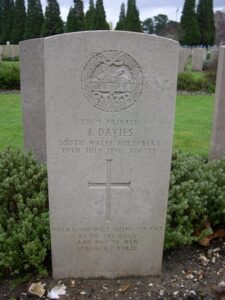
William Fanning, Private, 10868, Irish Guards. William was born at Ballymony, Wexford, and resided at Pembrey prior to the war. He enlisted at Llanelli into the 2nd Battalion, Irish Guards, who had begun the war as a Home Service Battalion, and on 17 August 1915 the Battalion transferred to 2 Brigade, Guards Division. This Division has the distinction of being formed in France in August 1915. The various Guards units that had been with other Divisions were withdrawn to be brought together to create this fine formation. It remained on the Western Front throughout the war and saw its first major action during the Battle of Loos on 25 September 1915, remaining in the area during the coming months, where they also fought in the subsequent Action of Hohenzollern Redoubt. In July 1916 the Division moved to the Somme, where they fought at the Battle of Flers-Courcelette, and then at the Battle of Morval, capturing Lesboeufs Village. They remained here for the winter, and in March 1917 took part in the advance caused by the German Retreat to the Hindenburg Line. Later that year they moved north to Ypres, where they fought at the Battle of Pilckem, where William was killed in action on 31 July 1917. He has no known grave, and so is remembered on the Ypres (Menin Gate) Memorial, Belgium. William is not commemorated locally.
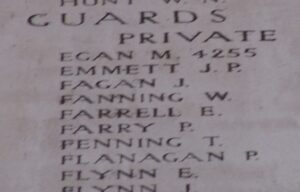
Thomas George, Second Lieutenant, Royal Welsh Fusiliers. Thomas was the son of John and Lettice George, of Brynhir, Pembrey. He had been commissioned into the 16th Battalion, Royal Welsh Fusiliers, who were attached to 113 Brigade, 38th (Welsh) Division. The Division landed in France during December 1915 and had spent their first winter in the trenches near Armentieres. In June they marched south to the Somme, where they famously captured Mametz Wood. The Division suffered terrible casualties at Mametz, and were taken out of the line, and moved to Ypres to rebuild. Here they fought at Pilckem and Langemarck, then moved to Armentieres, where they remained from September 1917 until March, 1918 when the German Spring Offensive was launched. The British had been over-run on the Somme, and so in April the Division was moved south, taking up positions North of Albert, from where they weathered the storm of the coming months, until the war turned during the Battle of Amiens, on 8 August 1918. The Germans had now lost the upper hand, and the 38th Division crossed the flooded River Ancre on 21 August 1918, launching their attack on Thiepval Ridge and Pozieres. Thomas was killed in action just six days into the offensive, near Longueval on 27 August 1918. He was 24 years old, and is buried at Caterpillar Valley Cemetery, Longueval, France.
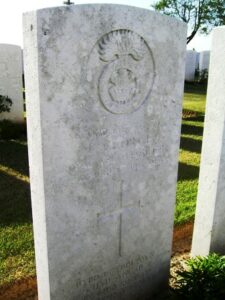
Frederick George Hallett, Private, 3220, Welsh Guards. Frederick was the son of George and Ellen Hallett, of 5, Wyndham Street, Plymouth, Devon. He resided at Pembrey prior to the war, and enlisted at nearby Llanelli into the 1st Battalion, Welsh Guards, which was in France attached to 3 Brigade, Guards Division. Frederick probably joined the battalion on the Somme in 1916. The Welsh Guards fought at the Battle of Flers-Courcelette, and then at the Battle of Morval, capturing Lesboeufs Village. They remained here for the winter, and in March 1917 took part in the advance caused by the German Retreat to the Hindenburg Line. Later that year they moved north to Ypres, where they saw heavy fighting during the Third Battle of Ypres. November saw them move south again, where they took part in the Battle of Cambrai. They remained in the area over the final winter of the war, and were stationed near Gouzeaucourt when the German Spring Offensive hit the area on 21 March 1918. The British retreated in the face of this onslaught, and the Guards Division fought a desperate rearguard action over the coming days. After this, the German Offensive petered out on the Somme, and on 8 August 1918 a gallant attack near Villers Brettoneux cracked the German superiority in the area, thus turning the war. On 21 August 1918 the British launched an attack on the Somme, and the Guards Division fought here at the Battle of Albert, and then pushed east, fighting at the Battle of Bapaume. From here on the Allies had the upper hand, and moved towards the Hindenburg Line, where the Guards Division fought at the Battle of Havrincourt and the Battle of the Canal du Nord. Frederick was killed in action here on 27 September 1918, aged 32, and is buried at Louverval Military Cemetery, Doignies, France.
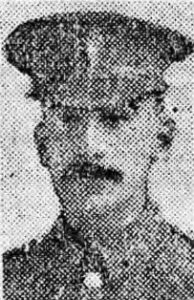
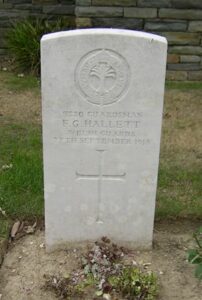
Alfred James Holt, Private, 32901, Kings Own Royal Lancaster Regiment. Alfred was the son of Thomas and Eliza Holt, of Brixworth, Northants. He enlisted at Pembrey into the 8th Battalion, Kings Own Royal Lancaster Regiment, which was attached to 76 Brigade, 3rd Division. In 1916 the Battalion fought at the Actions of the Bluff, and at the St Eloi Craters. They were then moved south, and fought throughout the Battle of the Somme, before settling into another bleak winter in France. In May 1917 the Division were at Arras, and fought at the First and Second Battles of the Scarpe, and at the Battle of Arleux and the Third Battle of the Scarpe, where they captured Rouex. Again they moved, this time back to Ypres, where they fought in the Third Battle of Ypres, at the Battle of the Menin Road and the Battle of Polygon Wood. In November the Division moved south again, where they fought at the Battle of Cambrai, and they were in the area during March, 1918 when the German Spring Offensive swept through the British lines, at the Battle of St Quentin and the First Battle of Bapaume. They then fought at the First Battle of Arras 1918 before being moved to Flanders to rebuild. However the Germans switched the focus of their offensive to Flanders, and the Division were caught up in the worst of the fighting there, at the Battle of Estaires, where Alfred was killed in action, on 13 April 1918, aged 40. He has no known grave, and so is remembered on the Ploegsteert Memorial, Belgium. Alfred is not commemorated locally.
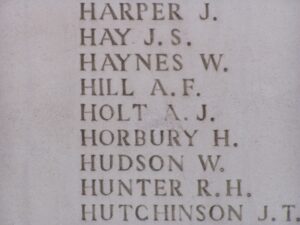
William James, Private, 20755, Welsh Regiment. William was the son of George and Ann James, of 2, Sandy Terrace, Llanelli. He enlisted at Llanelli on 11 March 1915 into the 15th Battalion, Welsh Regiment, known as the Carmarthen Pals Battalion. The battalion trained at Rhyl before moving to Winchester, as part of 114 Brigade, 38th (Welsh) Division. William landed in France with the battalion on 2 December 1915, and the division moved to the Fleurbaix sector for trench initiation. It remained here until moving to the notorious Cuinchy sector the following year, and it was there that William was wounded on 9 March 1916. He was evacuated home, but died at Swansea Hospital on 11 January 1917, aged 39. William was buried at Pembrey (St. Illtyd) Churchyard. William is not commemorated locally.
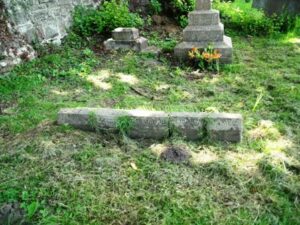
Evan Jones, Stoker, K/53294, Royal Navy. Evan was born in Aberystwyth, and was the Husband of Elizabeth Violet Jones, of 5, Council Houses, Ashburnham Road, Pembrey. He served with the Royal Navy at H.M.S. Vivid, which was the Naval Shore Establishment at Devonport. Evan died of pneumonia on 17 September 1918, aged 24, and is buried at Swansea (Danygraig) Cemetery. Evan is not commemorated locally.
Robert Jones, Private, 20187, Royal Welsh Fusiliers. Robert was the son of William and Margaret Jones, of 1, Yrdden Cottage, Ashburnham Road, Pembrey. He enlisted at Llanelli into the 14th Battalion, Royal Welsh Fusiliers. The Battalion was attached to 113 Brigade, 38th (Welsh) Division, and landed in France during December 1915, spending their first winter in the trenches near Armentieres. In June they marched south to the Somme, where they were tasked with the capture of Mametz Wood. The attack on the wood began on 7 July 1916, but met with fierce resistance, and was called off for three days, until a renewed attack was launched on 10 July. Robert was killed in action at Mametz on 11 July 1916, aged 23. He has no known grave, and so is remembered on the Thiepval Memorial, France.
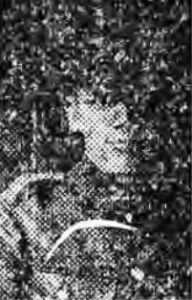
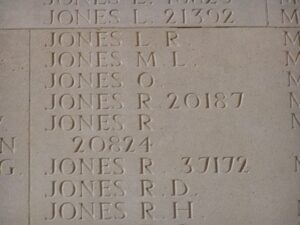
Gwilym Lewis, Driver, 118041, Royal Field Artillery. Gwilym was the son of Thomas and Rachel Lewis, of Pantycelyn, Pwll, Llanelli. He enlisted at Pembrey into the Royal Field Artillery, and was posted to D Battery, 52nd Brigade, Royal Field Artillery, which was attached to the 9th (Scottish) Division. During the summer of 1915 the Division moved to France, and saw its first major action during the Battle of Loos. They then took part in the Battle of the Somme, fighting at the opening Battle of Albert, and then at the Battle of Bazentin, where they captured Longueval. They then fought at the Battle of Delville Wood, and the Battle of Le Transloy, and in April, 1917 were at Arras, where they fought at the First Battle of the Scarpe and the Third Battle of the Scarpe. The Division moved to Ypres soon after, where it was to take part in the forthcoming Third Battle of Ypres. Gwilym was killed here on 21 July 1917, during the build up to the initial assault. He was 37 years old, and is buried at Dickebusch New Military Cemetery Extension, Belgium.
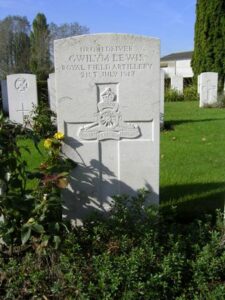
Montagu Stanley Melliss, Major, Cameronians. Montagu was born at Salford in 1852, the son of Robert McHattie Melliss and Agnes Melliss. He had been raised in Scotland, the lived with his wife Margaret Melliss in Dumbarton. He had served with the 1st Volunteer Battalion, Highland Light Infantry for many years after being commissioned in 1878, and then served with the 5th Battalion, Cameronians. He remained on home service for the duration of the war, based at the Pembrey Ordnance Factory. Montagu survived the war, but died at Swansea Hospital on 4 March 1919, aged 67, and is buried at Pembrey (St. Illtyd) Churchyard. His wife was still residing at Pembrey. Montagu is not commemorated locally.
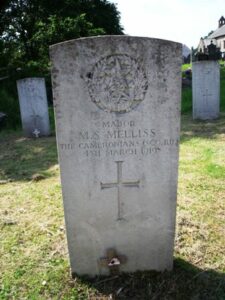
Astley John Onslow Thompson, VD, Lieutenant-Colonel, Australian Infantry. Astley was born near Pontypridd on 3 January 1865, the son of Astley and Udea Thompson. The family had resided at Llangendeirne for several years, before Astley emigrated to Australia, and had served for some years in the NSW Mounted Rifles, but had not fought in South Africa during the Boer War. Astley had managed the Camden Park Estate for many years, and despite being 49 years old at the outbreak of war, was seen as a man possessing the experience, drive and vitality required to raise, train and command the 4th Battalion, Australian Infantry, which was raised in New South Wales, and attached to 1st Brigade, 1st Australian Division. The battalion was raised within a fortnight of the declaration of war in August 1914, and embarked just two months later. After a brief stop in Albany, Western Australia, the battalion proceeded to Egypt, arriving on 2 December 1914. The battalion took part in the ANZAC landing on 25 April 1915 as part of the second and third waves, and pushed forward ahead of the neighbouring battalions, becoming isolated in a position known as Lone Pine. Astley was killed here that same day. He was 50 years old. His body was recovered weeks later and buried in the parapet of a trench, but he was later re-interred after the war at the 4th Battalion Parade Ground Cemetery, Gallipoli. Astley was Mentioned in Despatches by General Sir Ian Hamilton for his gallant conduct during the day of the landings. Astley is commemorated on an individual memorial within St. Iltyd’s Church and there is a private memorial to him in Pontyates Church.
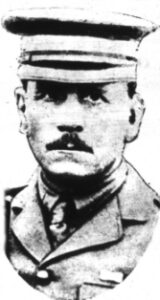
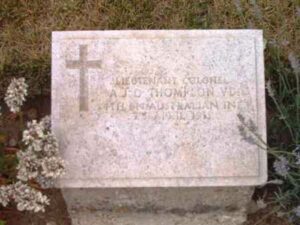
Griffith John Owen, Private, 229407, Monmouthshire Regiment. Griffith was the son of John and Jane Owen, of Tanygraig, Tregarth, Bangor. He worked at the Pembrey T.N.T. Factory at the start of the war, and enlisted at Carmarthen on 7 December 1915 into the army. Griffith was posted to France on 21 June 1917, joining the 1st Battalion, Monmouthshire Regiment, which was were attached to 84 Brigade, 28th Division. During March 1917 the Division followed the German Retreat to the Hindenburg Line, and then fought in the Battle of Arras, taking part in the Battle of Hill 70. In 1918 the Division was still in the area, when they were hit brought into action to attempt to stop the German Offensive. Griffith was killed in action during the desperate battle on 12 April 1918, aged 25, and is remembered on the Arras Memorial, France. Griffith is not commemorated locally.
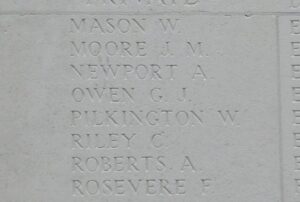
Francis Percy Campbell Pemberton, Captain, 2nd Life Guards. Francis was born at Gilling East, Yorkshire on 4 April 1885, the son of Reverend Thomas Percy Hudson and Sophia Patience Francis Hudson (née Campbell), of Trumpington Hall, Cambridge. Upon the death of her parents, Sophia became sole heir to the Pemberton estate, and the family assumed the surname of Pemberton. He was educated at Lovegrove and at Trinity College, Cambridge. When Francis came to age in 1906, his parents held the celebrations at the Muddlescombe Estate, where over 300 of their tenants attended. He was commissioned into the 2nd Life Guards on 12 February 1907. He married Winifred Mary Worsley, of 16, Prince’s Gardens, London, on 30 April 1912. Francis disembarked in France with the 2nd Life Guards on 8 October 1914. The unit spent the first weeks of the war on mobile reconnaissance duties, after joining the BEF at Ypres, attached to the 3rd Cavalry Brigade. The regiment was heavily involved in the First battle of Ypres, which raged from October to November 1914. Francis was killed in action at Moorslede on 19 October 1914, aged 29. His men were unable to recover his body, as they were retreating under a massed German attack. His body was, however, buried at some point, and he was re-interred after the war at Dadizeele New British Cemetery, Belgium. Francis is not commemorated on the Pembrey memorial.
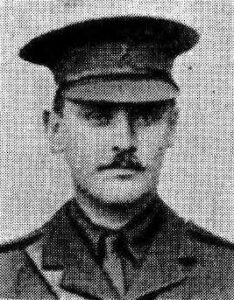
William Richard Rees, Gunner, 215412, Royal Field Artillery. William was the son of William and Ann Rees, of Gwernfa, Pembrey, and enlisted at Llanelli into the Royal Field Artillery. He was posted to the 107th Battery, 21st Brigade, attached to the Indian Army. William died of sickness in India on 23 October 1918, aged 23, and was buried there at Quetta Government Cemetery. He is now remembered on the Delhi Memorial (India Gate), India.
Owen Richards, Private, M/416802, Royal Army Service Corps. Owen was born at Craig-y-Deilo, Llanddowror on 22 May 1890, the son of David and Elizabeth Richards. He was educated at Llanddowror Church School, and joined the Army Service Corps, Motor Transport, as Private on 4 November 1918, being drafted to Woolwich Dockyard. He was however taken ill with influenza and bronchial pneumonia a few days after he joined up and died at the Davidson Road War Hospital, Carydon on 22 November 1918. Owen was 28 years old, and was brought to Pembrey for burial at Pembrey (Bethel) Calvinistic Methodist Churchyard.
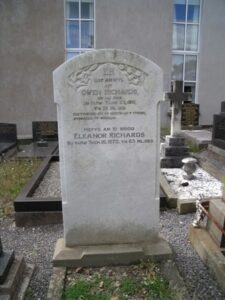
Thomas Frederick Styles, Leading Stoker, K/9463, Royal Navy. Thomas was born at Pembrey on 22 June 1889, the son of James and Mary Styles. The family later lived at 15, Beda Road, Canton, Cardiff. On 3 September 1907 Thomas enlisted into the Royal Navy, and over the coming years served on a variety of vessels before being posted to the Edgar-class cruiser HMS Grafton on 28 June 1915. Grafton was in the Mediterranean, lending support to the Gallipoli campaign, and used her guns to support the troops ashore at Suvla. She was struck by a salvo of Turkish shells on 12 August 1915, which caused some damage and killed nine of her crew. Thomas, who was 26 years old, was among the dead. He was buried at sea, and is commemorated on the Portsmouth Naval Memorial, Hampshire. He does not appear to be commemorated locally.
Walter Webber, Private, 45452, Welsh Regiment. Walter was born at Bristol, probably the son of William and Ellen Webber. The family had moved to Barry Docks prior to 1911, and Walter enlisted at Pembrey into the 11th Battalion, Welsh Regiment. The Battalion was formed in Cardiff during August, 1914, and became attached to 67 Brigade, 22nd Division. The Division crossed to France in early September 1915, but it’s stay in France was to be very short, as on 27 October 1915 the Division moved to Salonika. It remained in the theatre for the rest of the war, taking part in the Retreat from Serbia during December 1915. During August 1916 the Division fought at the battle of Horseshoe Hill, then in September 1916 at the battle of Machukovo. During April and May 1917 the Division fought at the battle of Doiran. A new attack was launched on 18 September 1918, called the Second Battle of Doiran, and this is where Walter was killed in action that day, aged 26. He is buried at Doiran Military Cemetery, Greece. Walter is not commemorated locally.
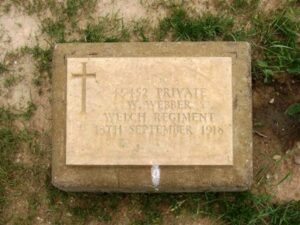
John Edwards Zachariah, Private, 56682, Welsh Regiment. John was born at Pembrey, the son of Henry and Margaret Zachariah. The family later resided at 3, Vernon Place, Briton Ferry. John had enlisted at Cardiff on 21 June 1915 into the 7th (Cyclist) Battalion, Welsh Regiment. He was posted to France on 11 June 1917, joining the 18th Battalion, Welsh Regiment, which was attached to 119 Brigade, 40th (Bantam) Division. This Division was formed between September and December 1915, composed of bantam units, and moved to France during June 1916, moving to the front near Loos. Late in 1916 they moved south to the Somme, and fought at the Battle of the Ancre, and remained in the area over the winter. In March 1917 the Germans withdrew to their shortened line, called the Hindenburg Line, and the 40th Division was one of the Divisions that followed the withdrawal. Later in the year they took part in the Battle of Cambrai, playing an important role in the attack on Bourlon Wood. John was killed in action at Cambrai on 24 November 1917. He was 25 years old, and has no known grave, and so he is remembered on the Cambrai Memorial, Louverval, France.
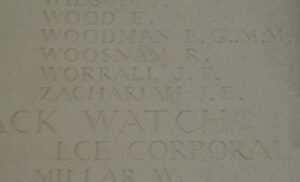
World War Two, 1939-1945
Spencer Rhys Bevan-John, Pilot Officer, 81933, Royal Air Force Volunteer Reserve. Spencer was the son of Rhys Bevan John, B.A., M.R.C.S., L.R.C.P. and Katharine Bevan John, of Pembrey. He was a Scholar of Brasenose College, Oxford, when he volunteered into the RAFVR, and trained as a Pilot. Spencer was posted to 53 Squadron, which flew the Bristol Blenheim IV, based at Thorney Island. Soon after the outbreak of war 53 Squadron moved to France to undertake strategic reconnaissance duties. The Squadron returned to the UK in May 1940 to fly reconnaissance missions from south-east England and in July began bombing sorties. Spencer must have been wounded on one of these sorties, as he died at home on 30 September 1940 aged only 19. He is buried at Pembrey (St. Illtyd) Churchyard. Spencer’s brother D.R.S. Bevan-John was captured by the Italians when he was a crew-member aboard a Sunderland of 228 Squadron, which was shot down in the Mediterranean on 6 August 1941.
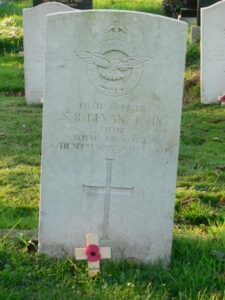
Brinley Colwill, Third Engineer Officer, Merchant Navy. Brinley was the son of Leonard Henry and Margaret Elizabeth Colwill, of Pembrey, and served in the Merchant Navy aboard the S.S. Treverbyn (St. Ives). Brinley was killed when serving as the 3rd Engineer on the SS Treverbyn, when she was sunk by the German Submarine U-82, en-route from Russia to Manchester in Convoy SL-89, with a cargo of iron ore on 21 October 1941. He was 23 years old, and is remembered on the Tower Hill Memorial, London.
Evan Arthur Davies, Flight Lieutenant (Pilot), 101537, Royal Air Force Volunteer Reserve. Evan was the son of Evan Jenkin and Catherine Davies, and the husband of Elizabeth Lilian Davies, of Pembrey. He served with 50 Squadron, RAF, which flew the Avro Lancaster I, based at Skellingthorpe. In 1942, 50 Squadron converted to Avro Manchesters, then to Avro Lancasters, and in October of that year contributed twelve Lancasters to No. 5 Group’s celebrated low-Ievel dusk raid on the Schneider works at Le Creusot. In 1943 it took part in the first shuttle-bombing raid (when the targets were a radar factory at Friedrichshafen and the Italian naval base at Spezia), and the epic raid on the German V-weapons experimental establishment at Peenemunde. On the night of 13 February 1943 Evan and his crew took off from Skellingthorpe, and formed part of a massive 466 bomber raid on Lorient. Evan’s Lancaster was sadly one of just two that were intercepted and shot down on the outward flight, and it cam down in France. Evan was killed in the crash, aged 32, and is buried at Gavres Communal Cemetery, France. Evan is not commemorated locally.
Vincent Howell Davies, Fusilier, 4198779, Royal Welch Fusiliers. Vincent was the son of Stephen and Sarah Davies, and served with the 1st Battalion, Royal Welch Fusiliers. In 1942 the Battalion sailed for the Far East, and arrived in India at the end of May 1942. They fought during the campaign in Burma against the Japanese, which is where Vincent was killed, during the Battle of Kohima, on 6 May 1944. He was 26 years old, and is remembered on the Rangoon Memorial, Myanmar.
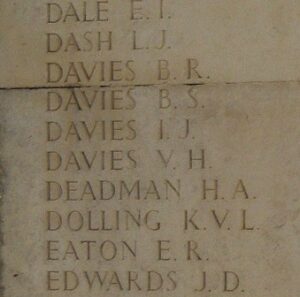
William David Davies, Able Seaman, D/JX 291205, Royal Navy. William was the son of David and Sophia Jane Davies, of Pembrey, and served in the Royal Navy at H.M.S. President III. President was a Naval Shore Base, and William had been attached from there to serve on the S.S. Solon II, which was a French ship that had been seized from the Vichy French, and pressed to use with the British Merchant Navy. She was torpedoed and sank off Brazil on 2 December 1942. William was killed with the sinking of the ship that day. He was just 21 years old, and is remembered on the Plymouth Naval Memorial, Devon.
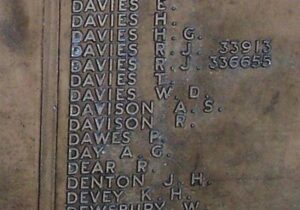
Lawrence Winson Gange, Private, 3970535, Welch Regiment. Lawrence was the son of Charles and Harriet Gange, of Burry Port, and the husband of Margaret Gange. He served with the 1st Battalion, Welch Regiment, which was in Palestine at the outbreak of war. They served in the Western Desert before being moved to Crete, where they were virtually annihilated, before the survivors were evacuated to North Africa. Here they again suffered badly, and were rebuilt before taking part in the Invasions of Sicily and then Italy, which is where Lawrence was killed on 19 September 1944. He was 32 years old, and is buried at Gradara War Cemetery, Italy.
Arthur Charles Gravelle, Lieutenant, Royal Naval Reserve. Arthur was born at Pembrey in 1908, the son of David John Gravelle, and of Agnes Mildred Gravelle. He had served with the Royal Naval Reserve for several years prior to the war, and after his father’s death in 1917, his mother moved to Cheam, Surrey. Arthur served aboard H.M.S. Manistee, which was a converted merchant steamer, lightly armed with four guns. On 24 February 1941, Manistee was part of Convoy OB-288 which had dispersed in the Atlantic, when she was torpedoed and sunk by the German Submarine U107, with the loss of all of her crew of 140 men. Arthur was 32 years old when he died that day, and is commemorated on the Portsmouth Naval Memorial, Devon. He is commemorated on his parent’s grave at Pembrey (St. Illtyd) Churchyard, but is not commemorated on either the Burry Port or Pembrey Memorials.
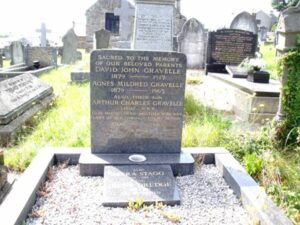
Frederick Gravell, Able Seaman, D/JX 165666, Royal Navy. Frederick was the son of Mr. and Mrs. John Gravell, of Pembrey, and served with the Royal Navy aboard H.M.S. Gloucester. In September 1939, Gloucester was flagship of the 4th Cruiser Squadron, serving in the East Indies and spent the rest of that year patrolling the Indian Ocean. In December, she was moved to Simonstown, South Africa where she was used, unsuccessfully, against German raiders. She was transferred again in May 1940, this time to the Mediterranean, where she experienced plenty of action. She was involved in Malta convoys and the Battle of Calabria on 9 July 1940. An Italian air attack on 8 July had hit the ship’s bridge killing or wounding most of the bridge personnel, including the Captain. The second half of 1940 was spent in the eastern Mediterranean and in the Aegean. On 11 January 1941, while supporting Operation Excess (several coordinated convoys), Gloucester was hit by a bomb which failed to explode. In March, she was at the Battle of Matapan and, in April, performed several bombardments along the North African coast. A second bomb hit caused minor damage. Gloucester formed part of a naval force acting against German military transports to Crete, with some success. On 22 May 1941, while in the Kithera Channel, about 14 miles north of Crete, she was attacked by German Stuka dive bombers and sank, having sustained at least four heavy bomb hits and three near-misses. 723 lives were lost, with just 82 survivors. Her sinking is considered to be one of Britain’s worst wartime naval disasters. Frederick was one of the poor souls lost aboard the Gloucester that day. He was 33 years old, and is remembered on the Plymouth Naval Memorial, Devon.
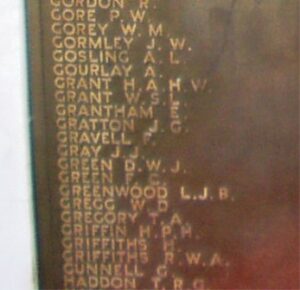
Benjamin Griffiths, Private, 3963640, Welch Regiment. Benjamin served with the 4th Battalion, Welch Regiment, which was the local Territorial Battalion for West Wales. Very little is known of him, but he died at sea on 2 July 1940 and is remembered on the Brookwood Memorial, Surrey. He was 33 years old. Two steamships were sunk that day. The Aeneas was bombed and sank by German Aircraft off Plymouth, and the Arandora Star was torpedoed off the Northwest coast of Ireland by the U-47, commanded by Gunther Prien. Over 600 Italian and German detainees who were being transported to Canada were lost in the sinking of the Arandora Star. Benjamin was probably aboard one of these ships.
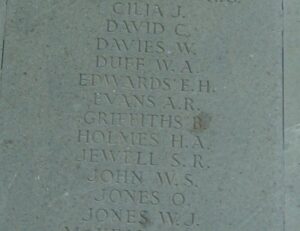
Gwynfryn James Griffiths, Civilian. Gwynfryn was the son of William J. and Louisa Griffiths, of 4 Block, Penybedd, Pembrey. He worked at the Royal Ordnance Factory at Pembrey, which made TNT for use in shells. On 10 July 1940, the factory was bombed by the Luftwaffe, and Gwynfryn was one of many injured men brought to the Llanelli Hospital for treatment, but he sadly died that same day. He was just 19 years old, and is buried locally. Gwynfryn is not commemorated locally.
James Havard, Police Sergeant. James was a Policeman, of Ashburnham Road, Pembrey, who was on duty at the Pembrey Royal Ordnance Factory on the day of 10 July 1940 when it was bombed. He was badly injured, and taken to Llanelli Hospital, but sadly died there the following day, on 11 July 1940. James was 64 years old, and is buried locally. James is not commemorated locally.
David Alan Vaughan John, Sergeant (Pilot), 1385838, Royal Air Force Volunteer Reserve. David was the son of Arthur S. and Ethel E. John. He served with 35 Squadron, RAF, which was re-formed in November, 1940 for the express purpose of introducing the new Handley Page Halifax into operational service. It flew its first sorties on Halifaxes on the night of 11/12 March 1941, when the target was Le Havre. During the rest of 1941 the squadron bombed a variety of targets in Germany and occupied France, some of the raids being undertaken in daylight. In July, 35 Squadron made its first raid on Berlin, and in September made the 1,700-mile trip to Turin in Northern Italy. In February 1942, it was one of the squadrons which attempted to stop the German warships Scharnhorst and Gneisenau during their escape dash from Brest to North German ports. April saw two unsuccessful attacks on the Tirpitz lying near Trondheim fjord, and at the end of May the squadron contributed 18 Halifaxes to the historic 1,000-bomber raid on Cologne. When the Pathfinder Force was formed in August 1942, with the object of securing more concentrated and effective bombing by marking targets with incendiary bombs and flares dropped from aircraft flown by experienced crews, using the latest navigational equipment, No. 35 was one of the five squadrons selected to form the nucleus of the new force. The first Pathfinder Force attack was against Flensburg on 18/19th August 1942, and the new technique soon proved its value. David was killed when his Halifax was brought down over Holland on 28 August, 1942. He is buried at Flushing (Vlissingen) Northern Cemetery, Netherlands.
Henry James Jones, Sick Bay Assistant, D/MX 80956, Royal Navy. Henry was the son of Abraham and Edith Jones, of Pembrey, and served in the Royal Navy aboard H.M.S. Jaguar. HMS Jaguar was a J class destroyer of the Royal Navy laid down by William Denny, Brothers and Company, Limited, of Dumbarton in Scotland on 25 November 1937, launched on the 22nd November, 1938 and commissioned on 12 September 1939. Jaguar participated in Operation Abstention in February and the Battle of Cape Matapan in March 1941. Jaguar was struck by two torpedoes fired by the enemy German submarine U-652 and sank off Sidi Barrani in Egypt on 26 March 1942 with the loss of 190 of her crew. Henry was one of the men lost that day. He was 21 years old, and is remembered on the Plymouth Naval Memorial, Devon.
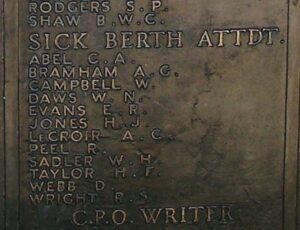
William Thomas Jones, Gunner, 1063392, Royal Artillery. William was born in about 1906. He married Gladys May Kelly in 1933 and the couple lived in Pembrey. William served with the 563rd Coastal Regiment, Royal Artillery. This was an Anti-Aircraft unit that had been formed at Deal in April, 1941, but little else can be found of them. William died in Swansea on 11 October 1943 aged 37, and is buried at Pembrey (St. Illtyd) Churchyard.
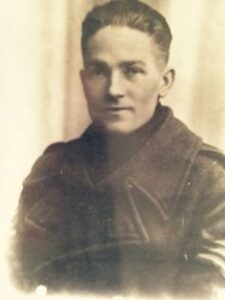
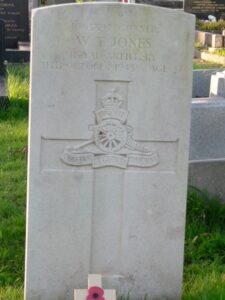
John C. Knowles, Fourth Engineer Officer, Merchant Navy. John was the son of Mr. and Mrs. Reginald Knowles, of Pembrey and served in the Merchant Navy aboard the M.V. Darlington Court (London). Darlington Court was a British Motor Cargo Vessel of 4,974 tons built in 1936. On 20 May 1941 when on route from New York via Halifax to Liverpool in Convoy HX-126, and carrying a cargo of 8,116 tons of wheat and aircraft, she was torpedoed by German submarine U-556 when 126 miles south of Cape Farewell. The master Charles Hurst, ten crew members and one gunner from the Darlington Court were picked up by the rescue ship Hontestroom and landed at Reykjavik on 27 May. Twenty-two crew members, three gunners and three passengers were lost, one of which was the 20 year old John Knowles. He is remembered on the Tower Hill Memorial, London.
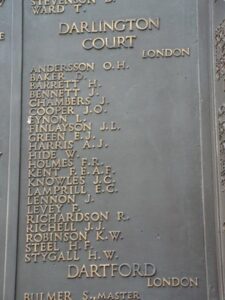
John Mansel-Lewis, Flying Officer (Pilot), 42248, Royal Air Force. John was born on 11 October 1920, the son of Archie and Muriel Mansel-Lewis, of Cliff Cottage, Pembrey. He was educated at Larbrook, Bracknell and at Stowe, and joined the RAF in May 1939. John was posted to 27 Squadron, which flew the Bristol Blenheim IF, based at Kallang in Malaya. When the Japanese invaded Malaya, the Squadron virtually ceased to exist. John was killed there on 4 April 1941, aged just 20, and is buried at Kranji War Cemetery, Singapore.
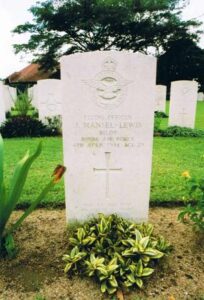
John S. Moss, Gunner, 1761124, Royal Artillery. John was the son of Charles and Martha Moss, of Pembrey, and served with the 56th Light Anti Aircraft Regiment, Royal Artillery. The Regiment had served during the Battle of Norway, and after evacuation had moved to North Africa, taking part in the Campaign in the Western Desert. They then took part in the invasion of Italy, where John was killed on 13 November 1944. He was 37 years old, and is buried at Florence War Cemetery, Italy.
William Richard Rees, MID, Staff Sergeant, 7608876, Royal Army Ordnance Corps. William was the son of John and Gwenllian Rees, of Pembrey, and served with the Royal Army Ordnance Corps. William had been Mentioned in Despatches at some time during the war, and died in Egypt on 9 January 1944, aged 25. He is buried at Kantara War Memorial Cemetery, Egypt.
David Edward Reynolds, Private, 14206549, The Queen’s Royal Regiment (West Surrey). David was the son of Frederick and Dorcas Reynolds, of Pembrey, and served with the 2/7th Battalion, the Queen’s Royal Regiment. The Battalion had been in France with the BEF in 1940, and had been evacuated from Dunkirk. They then joined the 8th Army in the Western Desert, and fought throughout the campaign there, and at the invasion of Italy, at Salerno and Anzio. David was killed in Italy on 29 January 1945. He was 22 years old, and is buried at Forli War Cemetery, Italy.
William Leyson Rhys, Sergeant (Pilot), 1380898, Royal Air Force Volunteer Reserve. William was the son of Tudor Leyson Rhys and Miriam Rhys, of Pembrey. William enlisted into the Royal Airforce Volunteer Reserve and trained as a pilot before joining 1655 MTU, which was a Mosquito Conversion Unit. On 31 October 1920 William took off from his base at REF Marham in Norfolk aboard Mosquito DZ346, with Flying Officer David Hornsby as his Flight Officer. The aircraft struck a tree in poor weather conditions and crashed near Bury St. Edmunds, killing both men. The body of 20-year-old William was brought back home to Pembrey, and he was buried in Pembrey (St. Illtyd) Churchyard.
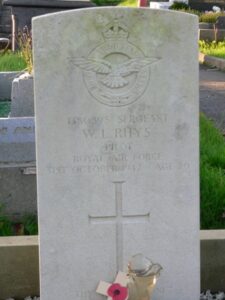
Alexander Macdonald Smith, Second Lieutenant, 99738, Royal Northumberland Fusiliers. Alexander was the son of Alex and Ada Macdonald Smith, of Pembrey, and served with the 7th Battalion, Royal Northumberland Fusiliers. The Battalion served as a Machine Gun unit, attached to the 51st (Highland) Division, which was stationed in France on the Maginot Line in 1940. They had thus escaped being encircled with the rest of the BEF at Dunkirk, and was then pulled back to the west of Northern France, where it was attached to the French 10th Army. For some time, it was forced to hold a line four times longer than that which would normally be expected of a division. During this period, the 154th Brigade was detached and withdrawn successfully. However, 152 and 153 Brigade were trapped at Saint-Valéry-en-Caux, and surrendered on 12 June 1940. Alexander was killed that very day of the surrender of the Battalion. He was 23 years old, and is buried at Houdetot Churchyard, France.
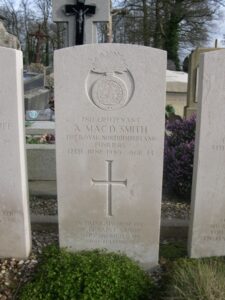
Gordon Ashton Twyford, Writer, D/MX 64722, Royal Navy. Gordon was the son of Christopher B. and Mary Twyford, of Pembrey, and served in the Royal Navy aboard HMS Lively. She was an L-Class Destroyer, and had seen much service in the North Atlantic, and during the Battle of Norway, before being moved to the Mediterranean, where she took part in the Malta Convoys. On 10 May 1942, Lively was sent as part of a small task force to intercept a German Convoy on passage to Benghazi between Crete and North African coast. The force had been warned that there was limited air cover, and to return to Gibraltar if any enemy aircraft were spotted, but the following day they were spotted and attacked by Dive Bombers, and the Lively was sank very quickly in a position 100 miles NE of Tobruk with heavy loss of life. Gordon lost his life aboard her that day. He was 25 years old, and is remembered on the Plymouth Naval Memorial, Devon.
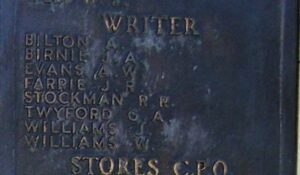
Thomas Henry Williams, Signalman, 2342946, Royal Corps of Signals. Thomas was the son of David and Harriet Williams, and the husband of Marion Kathleen Williams, of Burry Port. He served with 5 Air Formation Signals, Royal Corps of Signals, which served in the Middle East, in support of the Royal Air Force. They had been formed in Cyprus on 21 February 1942, and had moved to Palestine by 1943. Thomas was killed there, sometime between 26 and 27 August 1943. He was 24 years old, and is buried at Ramleh War Cemetery, Israel.
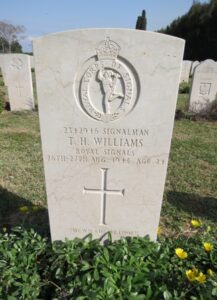
Unknown Airman
The body of a Royal Air Force airman washed ashore locally during May 1943, and was interred at Pembrey on 25 May 1943. His grave is marked with the headstone of an Unknown Airman.
